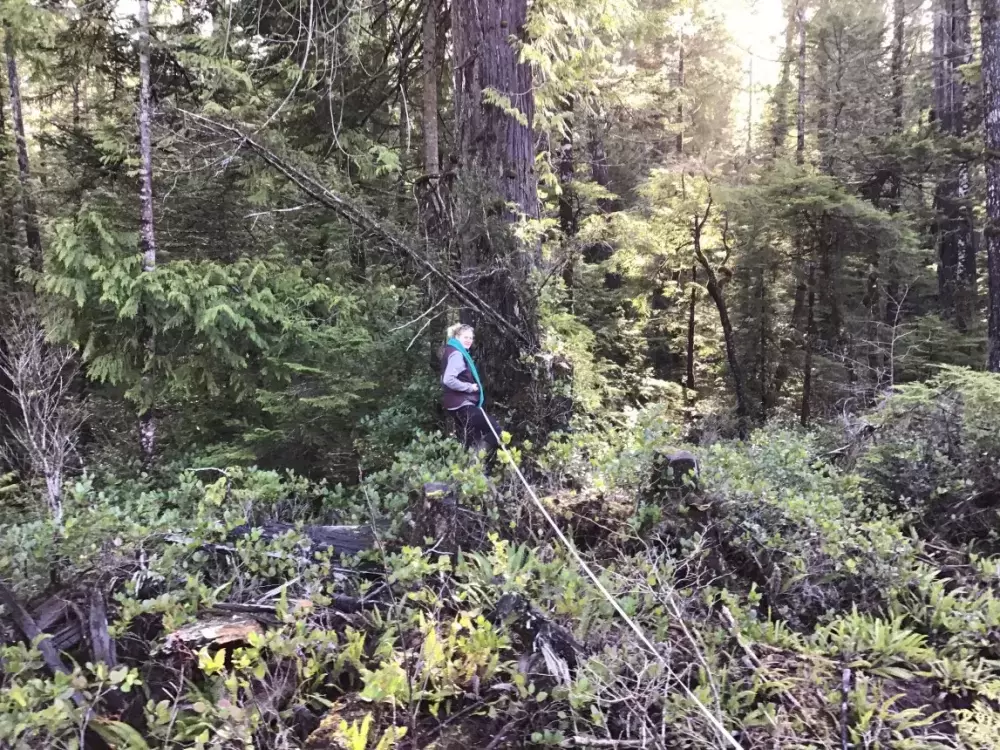Stefan Ochman received some unexpected but welcome news recently.
Last summer Ochman, president of the Bamfield Huu-ay-aht Community Forest Society (BHCFS), had written a grant proposal to the provincial government seeking funding through its Rural Dividend Program. But Ochman said most of the money went to forestry workers out of work due to the forest fires.
Ochman was obviously disappointed to hear in 2019 that the BHCFS would not receive any of the grant money it had requested.
“They just said next year would be another time (to apply for funding),” Ochman said.
The society had requested $32,450 to support the planning, initial layout of trails and the construction of a trail loop within the Bamfield Huu-ay-aht Community Forest. The 360-hectare forest is within the territory of the Huu-ay-aht First Nations, and adjacent to the communities of Bamfield and Anacla.
Though the BHCFS did not submit another grant proposal this year, Ochman received an email recently from provincial officials informing him his society would indeed by receiving all of the funds it had requested last year.
“The letter just said that because of COVID, they wanted to reboot the economy and that we could go ahead with this work,” Ochman said.
Earlier in June the provincial government sent out a news release announcing that the BHCFS would be one of more than 150 projects that would collectively receive almost $14 million in grants. The grants include about $5 million for 39 trail and recreation projects. And about $9 million is going to 114 projects that assist rural community development.
“As someone who lives in a rural community, I know that rural B.C. is the backbone of our economy,” said Doug Donaldson, the provincial minister of Forests, Lands, Natural Resource Operations and Rural Development. “The COVID-19 pandemic has impacted every region of our province, and I’m glad our government is providing these one-time grants to lend extra help to people, communities and economies in rural B.C.”
Projects chosen for the grants were picked from three categories. They were First Nations, municipalities and not-for-profit organizations.
Besides the BHCFS, other Nuu-chah-nulth groups to receive grant funding include the Hupacasath First Nation’s Kleekhoot Gold Bigleaf Maple Syrup Farm, Nuu-chah-nulth Seafood Limited Partnership and the Tseshaht First Nation’s Commercial and Industrial Land Development.
Hupacasath’s maple syrup business received $99,939 to expand, by increasing tree inventory by more than 50 per cent and by finding a second site for sap production.
The Nuu-chah-nulth Seafood Limited Partnership was granted $170,784. Funds will be used to analyze the capacity of communities on Vancouver Island’s west coast to deliver large-scale ocean farming of seaweed. Besides the gathering of information, the analysis of it will help determine available workforce, skill sets, infrastructure, warehousing, cold storage, approved processing facilities as well as transportation systems.
Meanwhile, the Tseshaht First Nation received $100,000. These funds will go towards building upon a market assessment and the 2018 Highest Best Use Study on its First Nation-owned commercial and industrial lands.
In its grant proposal last year, the BHCFS requested funds to flag the location of six walking trails in its forest in order to meet the recreation needs of residents and visitors. The proposal included a request for funding to construct a two-kilometre long trail loop, which would enhance the recreational tourism industry in the area.
Since they received recent notification that they would receive funding, BHCFS officials put out a request a couple of weeks ago to hire two flag technicians. As of late June, 10 applications had already been sent in. Applications are accepted until June 30.
Once the two technicians have been hired, Ochman said they flag a 15-kilometre area.
“We can’t do all 15 kilometres right away,” Ochman said of where ensuing trails will be constructed. “But we’ll go in and prioritize what we want to do first.”
Ochman anticipates the flagging of the forest will begin in early July.
“It depends on how fast they work,” Ochman said of the soon-to-be-hired technicians. “But it would be 15 days if they do a kilometre a day.”
The building of the trail would commence shortly after that.
“We have a few qualified people to do the work,” Ochman said.
Depending on which area of the forest is selected to be worked on first, the trail building could involve moving some trees or adding boardwalks.
“We’re trying to do it and make it look as natural as possible,” Ochman said. “We’re trying to make it look like the forest hasn’t been touched much.”
As part of their grant approval, BHCFS reps are required to submit progress reports to provincial officials.
An interim report will be required when the project is 50 per cent completed. A final project report must also be submitted. This final report needs to include confirmation all funding was spent on the project as well as the number of jobs it created and the economic benefits provided to the community.







